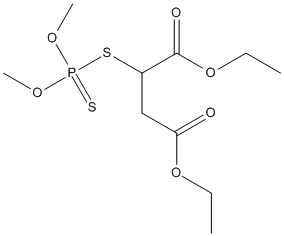Malathion
General
Type : Insecticide || Acaricide || Organophosphate || Sulfur compound || Organothiophosphate
Chemical_Nomenclature : diethyl 2-dimethoxyphosphinothioylsulfanylbutanedioate
Canonical SMILES :
InChI :
InChIKey :
Other name(s) : O,O'-dimethyl S-(1,2-dicarboxyethoxyethyl) phosphorothiolothionate or phosphorodithioate, s-(1,2-dicarbethoxyethyl) O,O'-dimethyldithiophosphate, O,O'-dimethyl S-(1,2-dicarbethoxyethyl) thiothionophosphate

Target
Families : No family
References (2)
| Title : Characterization of the insecticide detoxification carboxylesterase Boest1 from Bradysia odoriphaga Yang et Zhang (Diptera:Sciaridae) - Ding_2021_Pest.Manag.Sci__ |
| Author(s) : Ding Q , Xu X , Sang Z , Wang R , Ullah F , Gao X , Song D |
| Ref : Pest Manag Sci , : , 2021 |
| Abstract : Ding_2021_Pest.Manag.Sci__ |
| ESTHER : Ding_2021_Pest.Manag.Sci__ |
| PubMedSearch : Ding_2021_Pest.Manag.Sci__ |
| PubMedID: 34596943 |
| Gene_locus related to this paper: 9dipt-Boest1 , braco-est1 |
| Title : Degradation of malathion, in aqueous extracts of asparagus (Asparagus officinalis) - Okamoto_2004_J.Agric.Food.Chem_52_5919 |
| Author(s) : Okamoto Y , Shibamoto T |
| Ref : Journal of Agricultural and Food Chemistry , 52 :5919 , 2004 |
| Abstract : Okamoto_2004_J.Agric.Food.Chem_52_5919 |
| ESTHER : Okamoto_2004_J.Agric.Food.Chem_52_5919 |
| PubMedSearch : Okamoto_2004_J.Agric.Food.Chem_52_5919 |
| PubMedID: 15366843 |